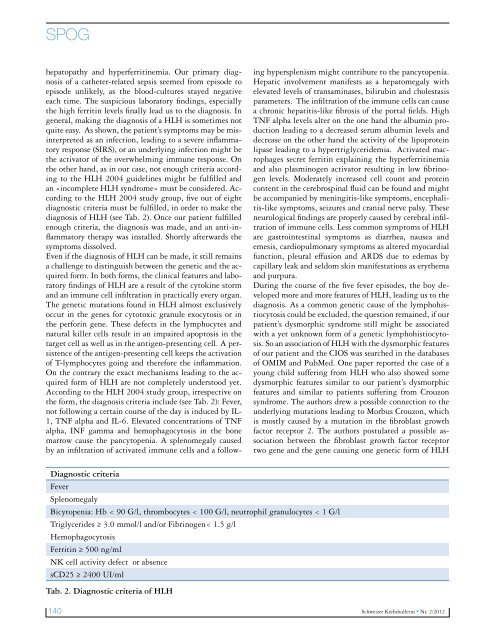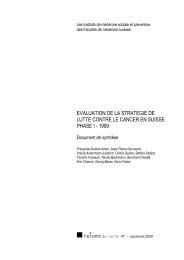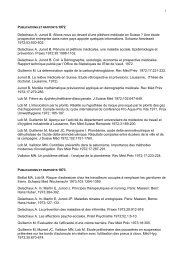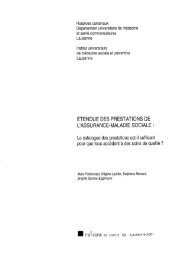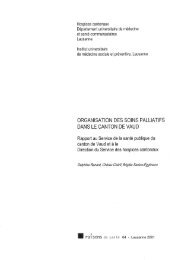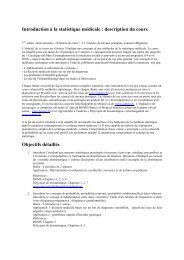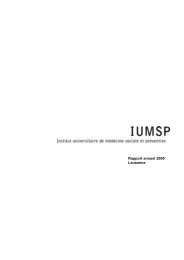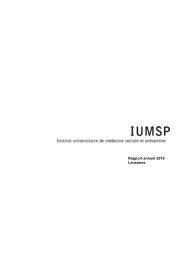Fortbildungen / Formations continues 2012 - IUMSP
Fortbildungen / Formations continues 2012 - IUMSP
Fortbildungen / Formations continues 2012 - IUMSP
Erfolgreiche ePaper selbst erstellen
Machen Sie aus Ihren PDF Publikationen ein blätterbares Flipbook mit unserer einzigartigen Google optimierten e-Paper Software.
SPOG<br />
hepatopathy and hyperferritinemia. Our primary diagnosis<br />
of a catheter-related sepsis seemed from episode to<br />
episode unlikely, as the blood-cultures stayed negative<br />
each time. The suspicious laboratory �ndings, especially<br />
the high ferritin levels �nally lead us to the diagnosis. In<br />
general, making the diagnosis of a HLH is sometimes not<br />
quite easy. As shown, the patient’s symptoms may be misinterpreted<br />
as an infection, leading to a severe in�ammatory<br />
response (SIRS), or an underlying infection might be<br />
the activator of the overwhelming immune response. On<br />
the other hand, as in our case, not enough criteria according<br />
to the HLH 2004 guidelines might be ful�lled and<br />
an «incomplete HLH syndrome» must be considered. According<br />
to the HLH 2004 study group, �ve out of eight<br />
diagnostic criteria must be ful�lled, in order to make the<br />
diagnosis of HLH (see Tab. 2). Once our patient ful�lled<br />
enough criteria, the diagnosis was made, and an anti-in-<br />
�ammatory therapy was installed. Shortly afterwards the<br />
symptoms dissolved.<br />
Even if the diagnosis of HLH can be made, it still remains<br />
a challenge to distinguish between the genetic and the acquired<br />
form. In both forms, the clinical features and laboratory<br />
�ndings of HLH are a result of the cytokine storm<br />
and an immune cell in�ltration in practically every organ.<br />
The genetic mutations found in HLH almost exclusively<br />
occur in the genes for cytotoxic granule exocytosis or in<br />
the perforin gene. These defects in the lymphocytes and<br />
natural killer cells result in an impaired apoptosis in the<br />
target cell as well as in the antigen-presenting cell. A persistence<br />
of the antigen-presenting cell keeps the activation<br />
of T-lymphocytes going and therefore the in�ammation.<br />
On the contrary the exact mechanisms leading to the acquired<br />
form of HLH are not completely understood yet.<br />
According to the HLH 2004 study group, irrespective on<br />
the form, the diagnosis criteria include (see Tab. 2): Fever,<br />
not following a certain course of the day is induced by IL-<br />
1, TNF alpha and IL-6. Elevated concentrations of TNF<br />
alpha, INF gamma and hemophagocytosis in the bone<br />
marrow cause the pancytopenia. A splenomegaly caused<br />
by an in�ltration of activated immune cells and a follow-<br />
Diagnostic criteria<br />
Fever<br />
Splenomegaly<br />
Bicytopenia: Hb < 90 G/l, thrombocytes < 100 G/l, neutrophil granulocytes < 1 G/l<br />
Triglycerides ≥ 3.0 mmol/l and/or Fibrinogen< 1.5 g/l<br />
Hemophagocytosis<br />
Ferritin ≥ 500 ng/ml<br />
NK cell activity defect or absence<br />
sCD25 ≥ 2400 UI/ml<br />
Tab. 2. Diagnostic criteria of HLH<br />
ing hypersplenism might contribute to the pancytopenia.<br />
Hepatic involvement manifests as a hepatomegaly with<br />
elevated levels of transaminases, bilirubin and cholestasis<br />
parameters. The in�ltration of the immune cells can cause<br />
a chronic hepatitis-like �brosis of the portal �elds. High<br />
TNF alpha levels alter on the one hand the albumin production<br />
leading to a decreased serum albumin levels and<br />
decrease on the other hand the activity of the lipoprotein<br />
lipase leading to a hypertriglyceridemia. Activated macrophages<br />
secret ferritin explaining the hyperferritinemia<br />
and also plasminogen activator resulting in low �brinogen<br />
levels. Moderately increased cell count and protein<br />
content in the cerebrospinal �uid can be found and might<br />
be accompanied by meningitis-like symptoms, encephalitis-like<br />
symptoms, seizures and cranial nerve palsy. These<br />
neurological �ndings are properly caused by cerebral in�ltration<br />
of immune cells. Less common symptoms of HLH<br />
are gastrointestinal symptoms as diarrhea, nausea and<br />
emesis, cardiopulmonary symptoms as altered myocardial<br />
function, pleural effusion and ARDS due to edemas by<br />
capillary leak and seldom skin manifestations as erythema<br />
and purpura.<br />
During the course of the �ve fever episodes, the boy developed<br />
more and more features of HLH, leading us to the<br />
diagnosis. As a common genetic cause of the lymphohistiocytosis<br />
could be excluded, the question remained, if our<br />
patient’s dysmorphic syndrome still might be associated<br />
with a yet unknown form of a genetic lymphohistiocytosis.<br />
So an association of HLH with the dysmorphic features<br />
of our patient and the CIOS was searched in the databases<br />
of OMIM and PubMed. One paper reported the case of a<br />
young child suffering from HLH who also showed some<br />
dysmorphic features similar to our patient’s dysmorphic<br />
features and similar to patients suffering from Crouzon<br />
syndrome. The authors drew a possible connection to the<br />
underlying mutations leading to Morbus Crouzon, which<br />
is mostly caused by a mutation in the �broblast growth<br />
factor receptor 2. The authors postulated a possible association<br />
between the �broblast growth factor receptor<br />
two gene and the gene causing one genetic form of HLH<br />
140 Schweizer Krebsbulletin � Nr. 2/<strong>2012</strong>


